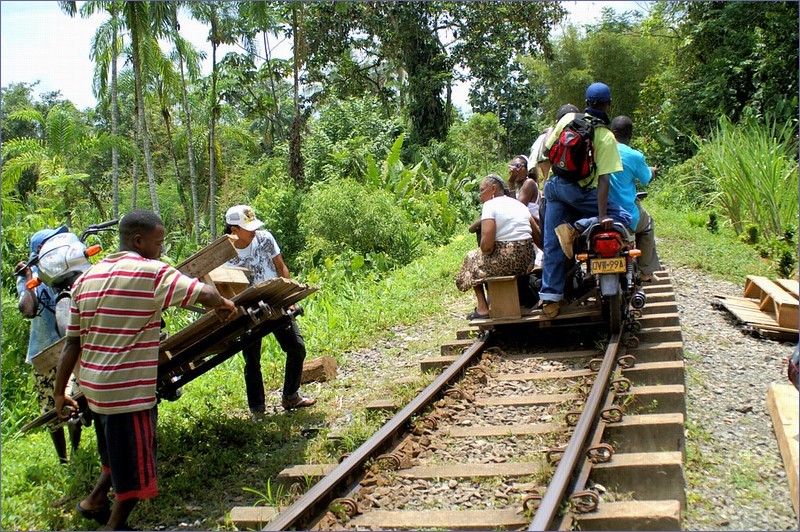Colombia has a well-developed railway network with a total length of 3,304 kilometres. Almost all lines are used exclusively for freight transport. Train travel in Colombia is limited to a weekend tourist train in Bogota and metropolitan railway in Medellin. Colombia has no operational railway links with adjacent countries. Railway link with Venezuela was disrupted, but there are plans to restore this railway border crossing.
Last updated: 12.06.2025
Tren Turístico de la Sabana
Tren Turístico de la Sabana is a heritage train. In the early 1990s Ferrocarriles Nacionales de Colombia ceased all passenger trains and the company was liquidated. Three years later a private company took over part of the abandoned railway line and assets of the liquidated Ferrocarriles Nacionales de Colombia. Rusty carriages and locomotives were abandoned in workshops. A few enthusiasta decided to set up a transport company and save rolling stock and make the necessary repairs.
The train service was inaugurated on May 29, 1993. Tren Turístico de la Sabana is one of Bogota’s most popular tourist attractions. It runs on Saturdays, Sundays and holidays all year round. Passengers can travel from Sabana station in Bogotá to Zipaquirá station. Total length of the route is 53 km. The train stops at several other stations, where travelers can transfer to buses to the most popular tourist attractions in the area.
The train is composed of a steam or diesel locomotive, vintage passenger cars and a bar car. The train can accommodate 580 passengers, and an additional program has been prepared, including performances by folk music bands.
Tren Turístico de la Sabana – official website

Train travel in Colombia – Metro in Medellin
The metro in Medellin is a rapid transit system, not an underground metro. The railway was put into operation in 1995 and currently has two lines and 25 stations. The 25.7 km long Line A connects Bello station in the north of the city with La Estrella station in the south. Eight of the 21 stations are located on the viaduct above the city center. The travel time between the start and end stations is 40 minutes. The second line – line B is 5.5 km long and has 6 stations. A journey between the first and last stations take 10 minutes. The average speed for both metro stations is 40 kilometers per hour, maximum speed is 80 km/h. The metro lines are served by 55 trains (165 wagons).
Medellin metro – official website

Funicular in Bogota
Many of tourists and pilgrims coming to Bogota want to visit Mount Monserrate (3,152 m above sea level), dominating the Colombian capital. There is a funicular railway or cable car to the pej. The funicular railway has been operating since August 18, 1929. The starting station is located at an altitude of 2,962 m above sea level. The funicular was modernized in 2003. The journey between the starting and ending stations takes 4 minutes. [5]
The Teleférico de Monserrate cable car has been operating since 1955. The ride also takes 4 minutes.
From the top of Monserrate hill visitors can admire a beautiful panorama of Bogota.

Tren Turístico Café y Azúcar (status unknown)
Tren Turístico Café y Azúcar was a popular tourist train suspended due to financial reasons in 2012. The train was reinstated in mid-2015. The train ran on selected weekends between Cali and La Cumbre. Shortly after train ran only on request of travel agencies. There were plans and great hopes. The authorities planned to open a second train route from Cali to La Tebaida via Buge. The biggest problem is the terrible condition of the infrastructure and rolling stock – a large part of the equipment has been stolen over the past five years.
Current status of the train is unknown.
Railbus Puerto Berrio – Barrancabermeja
In 2021, the freight carrier FENUCO launched a daily passenger service between Puerto Berrio and Barrancabermeja stations. Puerto Berrio is a former railway junction where the Ferrocarril del Antoquia and Ferrocarril del Atlantica lines crossed. The bus, converted into a rail vehicle, known to rail enthusiasts from Bolivia and Ecuador, runs on a 125-kilometer route that. A journey takes 4 hours. The railbus runs every day, leaving Barrancabermeja early in the morning, returning in the afternoon. The line runs through the jungle and sparsely populated areas. In 2022, a vehicle derailment occurred; it is not known whether it still runs.
Passenger trains in Colombia – other railways
Colombia, following the example of Cuba, decided to fight against the transport exclusion of towns that are rarely reached by public transport. Buses converted into rail vehicles are produced in one of the Colombian plants. Each vehicle can accommodate 45 people.
In 2022, there was information about the launch of a railbus from Santa Lucia station to Grifo de Yara. Two trains in each direction probably run on Mondays, Wednesdays, Fridays and Saturdays.
Railbuses probably also run around the town of Chaparra. However, I cannot verify this information.
There are motorcycle draisines on a freight or abandoned lines near Cali.

Railways in Colombia – development plans
The Colombian government announced plans to rehabilitate two railway lines:
La Dorada – Chiriguaná (750 km)
Belencito – Bogota (300 km)
These are lines built to 914 mm gaue. It was planned to regauge them to 1,435 mm gauge, but due to very high costs, the idea was ultimately abandoned. The lines will be intended for freight traffic, there are no plans to launch passenger trains.
There are also plans to build a high-speed railway (something between a tram and a railway) connecting Bogota with El Dorado international airport. The line would be 63 km long and the trains will run at a speed of 100 km per hour.
